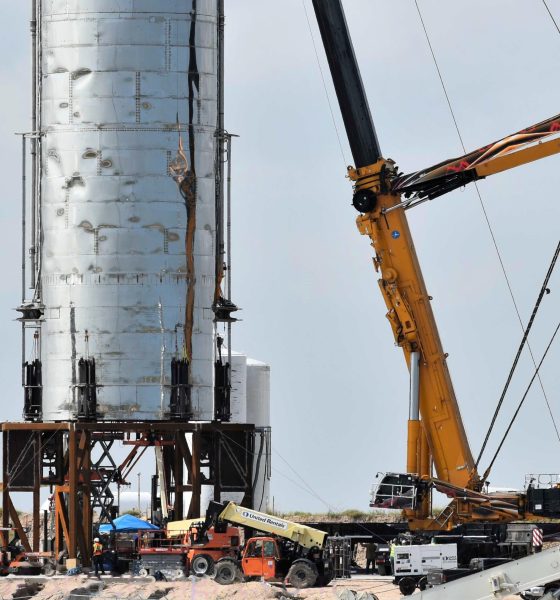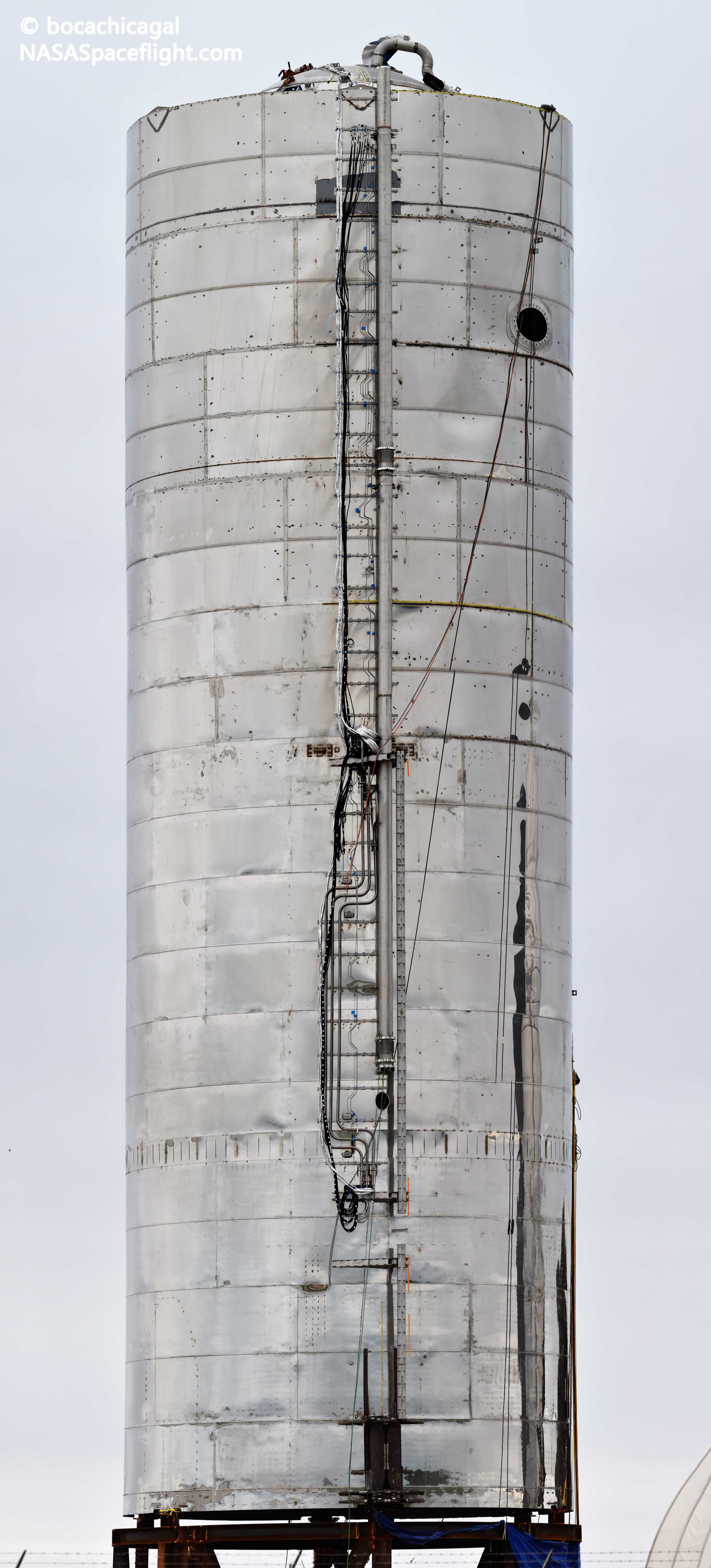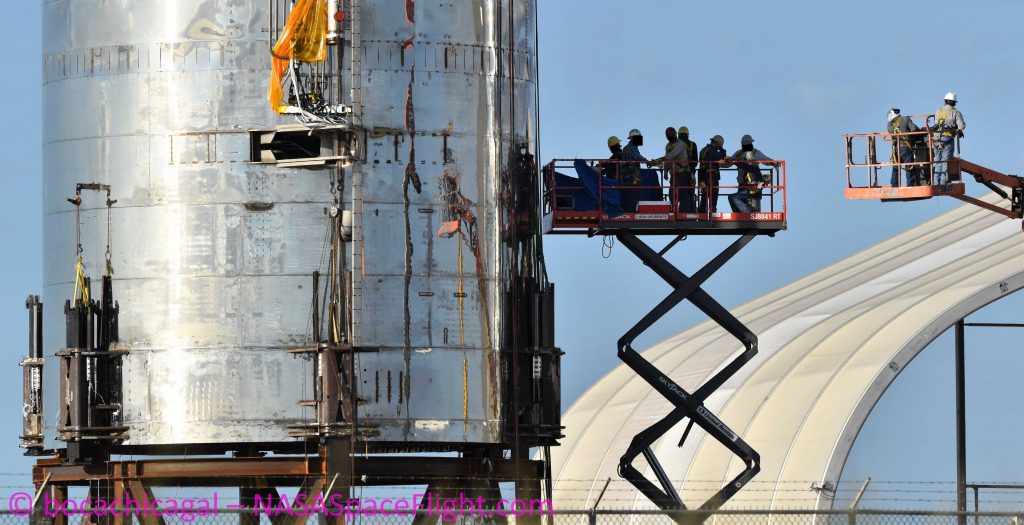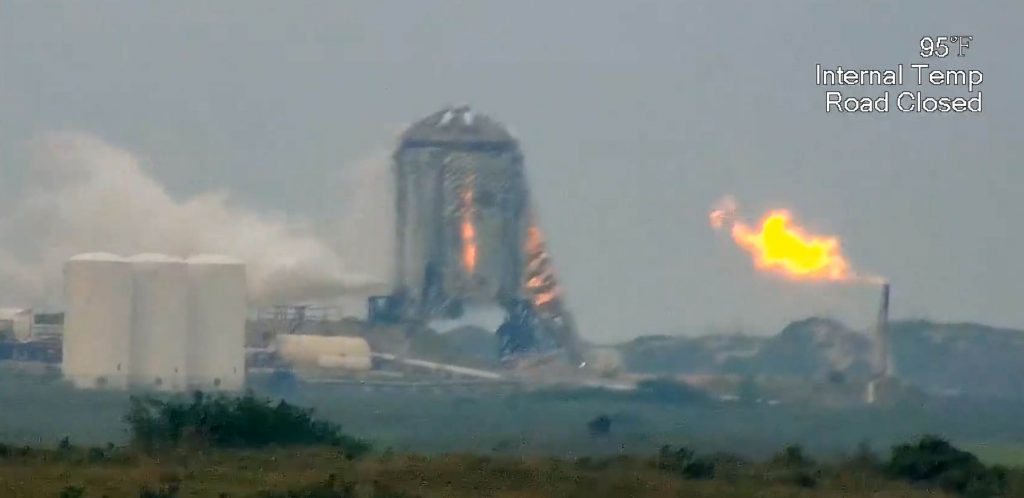

News
SpaceX’s Starship Mk1 prototype heads to the launch pad – but why?
SpaceX has transported (half of) its Starship Mk1 prototype to its South Texas launch pad for the first time ever, signifying that the company is about to enter a major new stage of testing.
The move, however, raises the question: why is SpaceX transporting only half of Starship Mk1 to the launch pad?
Following SpaceX CEO Elon Musk’s September 28th presentation on Starship, the spacecraft prototype was partially disassembled, having essentially been mocked up to stand as a backdrop at the event. The impact was fairly minor, taking up no more than a few days of work, but Starship Mk1 remains in two large, separate pieces – a curved nose section and the ship’s cylindrical propellant tank and propulsion section.

A little over a month after Musk’s presentation, SpaceX technicians freed Starship Mk1’s lower tank section from a steel mount and temporarily installed the giant half-spacecraft on framework mounted to a Roll Lift transporter. SpaceX has consistently relied on Roll Lifts for the task of transporting Starship’s massive segments both around and between its Boca Chica, Texas build and launch facilities. This time around, only Starship Mk1’s lower half was loaded onto the transporter before being staged overnight near the main gate of SpaceX’s build site.
Although work continued throughout the night, around dawn on October 30th, transport activity restarted in earnest, with technicians preparing to move Starship. A road closure filed with Cameron County suggested that something would occur on the 30th, with followers speculating that Starship Mk1 would be transported to SpaceX’s South Texas launch pad. As it turned out, that speculation was correct, and (half of) Starship Mk1 was indeed moved to the launch pad and installed atop a new launch mount that was built from scratch in just a few months.
(Half a) Starship on the pad
While it’s undeniably thrilling to see Starship Mk1 head to SpaceX’s Boca Chica launch pad for the first time ever, it remains to be seen why exactly only half of the rocket was transported – no mean feat. Although a great deal of progress has been made over the last month outfitting Starship Mk1 with all the wiring, electronics, plumbing, and other subsystems the prototype will need to function, it’s plainly visible that a significant amount of work remains before Starship will be ready for integrated testing.


Most notably, as pictured above, the launch mount frame is certainly more or less complete, but most of the complex plumbing, wiring, and power equipment it will need to serve its function is not obviously present. There is admittedly a possibility that SpaceX will reuse the ‘quick disconnect’ umbilical ports used by Starhopper on Starship Mk1, but that remains to be seen.

Additionally, Starship Mk1 also has some level of work left before it will be ready for its first propellant loading test, let alone flight. Aside from a large amount of wiring and avionics that still needs to be partially run, harnessed, and connected, Starship’s main liquid oxygen and methane feedlines – needed to fuel the rocket – are largely complete but still unfinished.
There are at least a few obvious possible explanations for SpaceX moving the Starship Mk1 tank section to the launch pad in its partially-finished state. The easiest explanation is that SpaceX wants to perform leak and pressure tests of Starship’s tanks as early as possible, even if that involves testing the rocket without its nose (the host of Mk1’s batteries, power controllers, COPVs, pressurization tanks, and more). It’s not clear that Starship Mk1 is – at present – capable of performing a wet dress rehearsal (WDR), a common aerospace test where a rocket is fully fueled and counts down to launch without actually igniting.

Instead, SpaceX could potentially perform a pressure (or at least leak) test with a neutral gas (or perhaps liquid nitrogen) just to verify that Starship Mk1 is structurally sound before kicking off cryogenic propellant loading. Additionally, it’s possible that SpaceX could get around Mk1’s incomplete propellant feed lines by attaching pad umbilicals directly to the ends of the incomplete feed lines.
At the same time, it’s possible that SpaceX has decided to finish assembling Starship at the launch pad itself, hinted at when a local photographer captured a number of Mk1’s control surfaces and aero covers being moved around shortly after Starship was moved to the pad. Time will tell. For the time being, SpaceX has no more road closures scheduled (meaning no nose section transport) until November 7th and 8th, followed by another on the 12th.
Stay tuned to find out what transpires!
Check out Teslarati’s Marketplace! We offer Tesla accessories, including for the Tesla Cybertruck and Tesla Model 3.

News
Tesla (TSLA) receives “Buy” rating and $551 PT from Canaccord Genuity
He also maintained a “Buy” rating for TSLA stock over the company’s improving long-term outlook, which is driven by autonomy and robotics.

Canaccord Genuity analyst George Gianarikas raised his Tesla (NASDAQ:TSLA) price target from $482 to $551. He also maintained a “Buy” rating for TSLA stock over the company’s improving long-term outlook, which is driven by autonomy and robotics.
The analyst’s updated note
Gianarikas lowered his 4Q25 delivery estimates but pointed to several positive factors in the Tesla story. He noted that EV adoption in emerging markets is gaining pace, and progress in FSD and the Robotaxi rollout in 2026 represent major upside drivers. Further progress in the Optimus program next year could also add more momentum for the electric vehicle maker.
“Overall, yes, 4Q25 delivery expectations are being revised lower. However, the reset in the US EV market is laying the groundwork for a more durable and attractive long-term demand environment.
“At the same time, EV penetration in emerging markets is accelerating, reinforcing Tesla’s potential multi‑year growth runway beyond the US. Global progress in FSD and the anticipated rollout of a larger robotaxi fleet in 2026 are increasingly important components of the Tesla equity story and could provide sentiment tailwinds,” the analyst wrote.
Tesla’s busy 2026
The upcoming year would be a busy one for Tesla, considering the company’s plans and targets. The autonomous two-seat Cybercab has been confirmed to start production sometime in Q2 2026, as per Elon Musk during the 2025 Annual Shareholder Meeting.
Apart from this, Tesla is also expected to unveil the next-generation Roadster on April 1, 2026. Tesla is also expected to start high-volume production of the Tesla Semi in Nevada next year.
Apart from vehicle launches, Tesla has expressed its intentions to significantly ramp the rollout of FSD to several regions worldwide, such as Europe. Plans are also underway to launch more Robotaxi networks in several more key areas across the United States.
News
Waymo sues Santa Monica over order to halt overnight charging sessions
In its complaint, Waymo argued that its self-driving cars’ operations do not constitute a public nuisance, and compliance with the city’s order would cause the company irreparable harm.

Waymo has filed a lawsuit against the City of Santa Monica in Los Angeles County Superior Court, seeking to block an order that requires the company to cease overnight charging at two facilities.
In its complaint, Waymo argued that its self-driving cars’ operations do not constitute a public nuisance, and compliance with the city’s order would cause the company irreparable harm.
Nuisance claims
As noted in a report from the Los Angeles Times, Waymo’s two charging sites at Euclid Street and Broadway have operated for about a year, supporting the company’s growing fleet with round-the-clock activity. Unfortunately, this has also resulted in residents in the area reportedly being unable to sleep due to incessant beeping from self-driving taxis that are moving in and out of the charging stations around the clock.
Frustrated residents have protested against the Waymos by blocking the vehicles’ paths, placing cones, and “stacking” cars to create backups. This has also resulted in multiple calls to the police.
Last month, the city issued an order to Waymo and its charging partner, Voltera, to cease overnight operations at the charging locations, stating that the self-driving vehicles’ activities at night were a public nuisance. A December 15 meeting yielded no agreement on mitigations like software rerouting. Waymo proposed changes, but the city reportedly insisted that nothing would satisfy the irate residents.
“We are disappointed that the City has chosen an adversarial path over a collaborative one. The City’s position has been to insist that no actions taken or proposed by Waymo would satisfy the complaining neighbors and therefore must be deemed insufficient,” a Waymo spokesperson stated.
Waymo pushes back
In its legal complaint, Waymo stated that its “activities at the Broadway Facilities do not constitute a public nuisance.” The company also noted that it “faces imminent and irreparable harm to its operations, employees, and customers” from the city’s order. The suit also stated that the city was fully aware that the Voltera charging sites would be operating around the clock to support Waymo’s self-driving taxis.
The company highlighted over one million trips in Santa Monica since launch, with more than 50,000 rides starting or ending there in November alone. Waymo also criticized the city for adopting a contentious strategy against businesses.
“The City of Santa Monica’s recent actions are inconsistent with its stated goal of attracting investment. At a time when the City faces a serious fiscal crisis, officials are choosing to obstruct properly permitted investment rather than fostering a ‘ready for business’ environment,” Waymo stated.
News
Tesla FSD v14.2.2 is getting rave reviews from drivers
So far, early testers have reported buttery-smooth drives with confident performance, even at night or on twisty roads.

Tesla Full Self-Driving (Supervised) v14.2.2 is receiving positive reviews from owners, with several drivers praising the build’s lack of hesitation during lane changes and its smoother decision-making, among others.
The update, which started rolling out on Monday, also adds features like dynamic arrival pin adjustment. So far, early testers have reported buttery-smooth drives with confident performance, even at night or on twisty roads.
Owners highlight major improvements
Longtime Tesla owner and FSD user @BLKMDL3 shared a detailed 10-hour impression of FSD v14.2.2, noting that the system exhibited “zero lane change hesitation” and “extremely refined” lane choices. He praised Mad Max mode’s performance, stellar parking in locations including ticket dispensers, and impressive canyon runs even in dark conditions.
Fellow FSD user Dan Burkland reported an hour of FSD v14.2.2’s nighttime driving with “zero hesitations” and “buttery smooth” confidence reminiscent of Robotaxi rides in areas such as Austin, Texas. Veteran FSD user Whole Mars Catalog also demonstrated voice navigation via Grok, while Tesla owner Devin Olsen completed a nearly two-hour drive with FSD v14.2.2 in heavy traffic and rain with strong performance.
Closer to unsupervised
FSD has been receiving rave reviews, even from Tesla’s competitors. Xpeng CEO He Xiaopeng, for one, offered fresh praise for FSD v14.2 after visiting Silicon Valley. Following extended test drives of Tesla vehicles running the latest FSD software, He stated that the system has made major strides, reinforcing his view that Tesla’s approach to autonomy is indeed the proper path towards autonomy.
According to He, Tesla’s FSD has evolved from a smooth Level 2 advanced driver assistance system into what he described as a “near-Level 4” experience in terms of capabilities. While acknowledging that areas of improvement are still present, the Xpeng CEO stated that FSD’s current iteration significantly surpasses last year’s capabilities. He also reiterated his belief that Tesla’s strategy of using the same autonomous software and hardware architecture across private vehicles and robotaxis is the right long-term approach, as it would allow users to bypass intermediate autonomy stages and move closer to Level 4 functionality.








